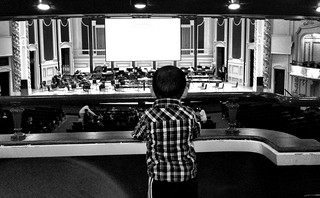My memorial day weekend project was to build a workbench. Now, I have not done real woodworking before, but a workbench is one of those traditional first projects. And since we really don't have a place to put a workbench I decided to make a sawhorse workbench with a plywood top that I can breakdown and bring it into the backyard when I want to work.
First the size. Well, actually, I was thinking of something less ambitious, like a toolbox. But I found this nice set of plans for a toolbox that could do double duty as a stool for working in the garden, and it required a 4' X 4' piece of plywood. But plywood does not come in that size. It comes in 2' X 4' or 4' X 8'. So I figured I'd get a 4' X 8' and whatever was left would become a workbench top. Which means I'm making a workbench. Now, that makes perfect sense, right?
First part, making the sawhorses. As a bonus we have a couple cabinet doors that we want to make into a table for T, so it is ok to mess up one set.
I did the first pair of sawhorses using a couple of sawhorse brackets. The idea is you put 2"X4" as the legs into the brackets, and the jaws of the brackets close down on another 2X4. (with everything screwed in for permanence. Problem: The brackets are just a little to small to fit in a 2X4. A quick search on Amazon.com reveals this is a common complaint. Apparently at least one manufacturer of these things doesn't recognize the difference between inner and outer diameter (I figure they are too small by just about the thickness of the metal. So after way too much work shaving the ends of the 2X4's, I had the first pair of sawhorses. These will someday turn into legs for a table for T.
 |
| Building sawhorse using sawhorse brackets. I'm going to saw these down to size so everything is clamped up. |
So, let's try again. This time I'm building these from lumber. There is a set of plans that basically call for making an I-beam and putting legs on them, so that is what I'll do. Now, I did a layout of the 4'X8' and figured I can fit the toolbox all in 4' X 37", which leaves 4' X 59" for the workbench. Cut that in half and I get a two-ply 4' X 29 1/2". I wanted a little more stability than you get from just a pair of sawhorses 3' apart so I will put in joist hangers so I can have a pair of crossbeams for more stability.
First, make the sawhorses. The joist hangers really don't work with an I-beam, so I'm making a T-beam, and attaching joist hangers to the vertical.
 |
| Joist hangers for the sawhorses |
Next, complete the crossbeam. The Workmate workbench is good for holding the vertical in place while I work. Also have a couple of blocks to help hold everything steady while I put in the horizontal beam.
 |
| Finishing the sawhorse beam. I'm a member of the "You can't have too many clamps" club |
Two crossbeams, then attach the legs (all this is using 3" drywall screws and a cordless screwdriver). Now I have two sawhorses with joist hangers for crossbeams.
 |
| Here is the frame of the sawhorse table. |
For the top, I took the two layers of plywood, then glued and screwed them together (using Elmer's wood glue and 1" wood screws) Clamp everything together overnight and I end up with a nice size worktable. (oh, this is after taking apart one of the sawhorses and putting it back together because it wasn't really square on one side)
 |
| My first workbench |
Some things still to do:
- Sand everything.
- Once I decide just where I want the table top in relation to the legs, I'll attach the crossbeams to the table top to give it more stability.
- Add in 3/4" bench dog holes. Once I figure out where they should go.
- Probably fut a finish on the top (Danish oil? Tung oil?)
- If I'm satisfied with the sawhorses (I probably will try to level them a bit better), I'll add in braces on the legs. And probably a shelf on one of them (just one, so they will still be stackable)
Some things I learned along the way:
1. Sawhorse brackets suck. Big thumbs down. I'll never get those again.
2. I probably was way too careful with clamping down while making the sawhorse. It was a lot easier when I broke one of them down to put back together just bracing everything by hand.
3. 2X4 are not all alike in size. Even when they come from the same batch. Measure according to the actual piece you are going to put in.
4. Jigsaws have to go real slow through 2X4's or they will bend.
Once I'm done sanding, I will actually get around to making that garden tool box that was the excuse for getting that plywood :-)






















